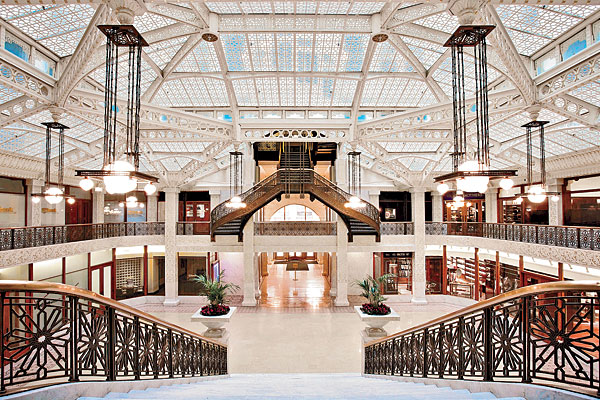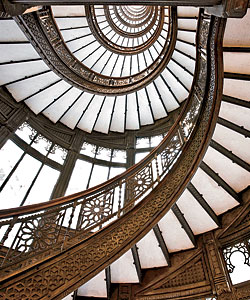
The Rookery still dazzles with its dramatic staircase and marble interior.
Related:
TOP 40 BUILDINGS IN CHICAGO »
Why the city reigns as the country’s architectural king
Earlier this year, the Frank Lloyd Wright Preservation Trust opened a tour center in the Rookery, one of the Loop’s great buildings. No one was surprised. The public’s fascination with Wright has spawned a huge industry for shrines, tours, and merchandise, and the trust’s tours of Wright’s home and studio in Oak Park and his Robie House in Hyde Park attract more than 100,000 visitors annually from all over the world.
But the Rookery is different. An 1888 masterpiece of the Chicago school of architecture, the building is a commercial structure, not a house. It’s urban, not suburban (Hyde Park was considered suburban in 1910, when Robie House was built). And another detail: The Rookery was designed not by Wright but by John Wellborn Root. Wright is properly credited with the interior renovation, but as he assumes the leading role in yet another cultural attraction, it seems that old Frank is definitely riding Root’s coattails on this one.
“It’s really a shame that more people don’t know about Root,” says Joanna Merwood-Salisbury, the author of Chicago 1890 (University of Chicago Press, $45), a recent reevaluation of early Loop skyscrapers. “Even though he died relatively young [at 41 in 1891], the body of work that he did leave is absolutely amazing.”

A partner in the firm Burnham & Root, Root designed the equally iconic Monadnock and Reliance Buildings (Charles Atwood shares credit for the latter). But the young architect never achieved the name recognition of Wright or even of his surviving partner, Daniel Burnham, because most of his structures have been demolished. Still, serious historians lionize Root for his seminal writing about organic architecture—the honest expression of structure, materials, and light. And Merwood-Salisbury insists that Root deeply influenced Louis Sullivan, who led the next generation of architects, including Wright, toward distinctly modern styles.
In the new Rookery tours, guides acknowledge Root’s original design, but the talks focus on Wright’s contributions. The volunteers graciously describe Wright’s interior renovation as “a very restrained and reverential handling [of Root’s design],” says the trust’s director of volunteer resources, Kent Bartram. But, he explains, “we have more of a Wrightian approach.” Bartram calls Wright’s work an “editing,” or simplifying, of the arabesque and other original ornament. Wright also lightened the color palette, replacing much of the cast iron with white Carrara marble—this choice considered modern after the triumph of the 1893 World’s Columbian Exposition and its White City.
“It really is a cult, isn’t it?” says Merwood-Salisbury when asked about prevalent interest in everything Frank Lloyd Wright. “He’s become a figure of popular history, and it’s very rare for an architect to do that.”
Gunny Harboe, who directed the restoration of the Rookery in 1992 and the Reliance in 1999, says he considers the Rookery a Burnham & Root building first—but is unfazed by the relentless focus on Wright. “He lived forever. He did a lot of work,” Harboe says. “He had a lot of disciples. They all spread the word.”
“We’ve come full circle,” says Jim Schiefelbein, the Wright trust’s chairman. By “circle,” he means that Wright kept an office in the Rookery while doing the design work in Oak Park, where the trust itself began.
Fair or not, adding the Rookery to Wright’s catalog might give one of architecture’s famous egos, if he were alive, a moment of unaccustomed humility. Looking at it another way, it’s possible that the reputation of Root—a man who is hardly an architecture rock star—might enjoy some new and much-needed burnishing by falling into Wright’s powerful slipstream.
GO Tour the Rookery (209 S. LaSalle St.) on Mondays, Wednesdays, and Fridays at noon; for info, gowright.org.
Photography: Courtesy of The Rookery



